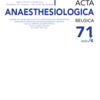A prospective randomized controlled trial of the Baska® mask and the LMA Supreme® in patients undergoing laparoscopic cholecystectomy
Baska® mask ; LMA Supreme ; oropharyngeal seal pressure ; laparoscopic cholecystectomy
Published online: Mar 30 2020
Abstract
Objectives : LMA Supreme® (LMA-S) mask is one of the most used and proved supraglottic airway devices (SADs) for laparoscopy. The Baska® mask is a relatively new SAD with an inbuilt drain channel and just a limited experience has been reported with this device. We compared these two SADs with regard to safety, efficacy, ease of use and incidence of adverse events for laparoscopic cholecystectomy.
Methods : Prospective, randomized, controlled study of two groups of 40 patients each, undergoing elective laparoscopic cholecystectomy. After induction of general anesthesia (maintained with 5% desflurane in 50% oxygen and air, remifentanil 0.2-0.5 μg kg-1 min-1 and rocuronium 0.6 mg kg-1), we evaluated, success rates, speed of insertion, ease of insertion of the drain tube, leak pressure, tidal volume and airway pressures (peak pressure and plateau pressure). We also recorded intraoperative adverse events and postoperative oropharyngeal discomfort.
Results : Success rate on first attempt insertion was higher for the LMA-S group than the Baska® mask group (97.5% and 60% respectively; p < 0.001). There was no difference in the median time taken for the insertion between groups (p = 0.93). Ease of insertion of the drain tube differed significantly and it was slightly easy inserted in the LMA-S group (p = 0.04). Leak pressure was similar between the groups (p = 0.61) and it was consistent with a similar tidal volume achieved (p = 0.10). Both devices showed equal sore throat scoring at 2h postoperatively (p = 0.24).
Conclusions : We found that LMA-S was an easier device to insert than the Baska® mask, showing a better success rate on first attempt insertion. Insertion of the drain tube was also easier for the LMA-S group. Seal pressure and tidal volume achieved were similar between groups. Complication rates and postoperative OPD scoring are comparable for both devices.
